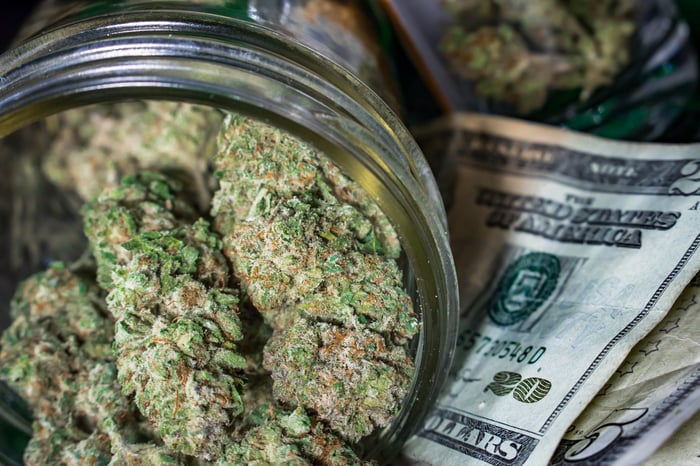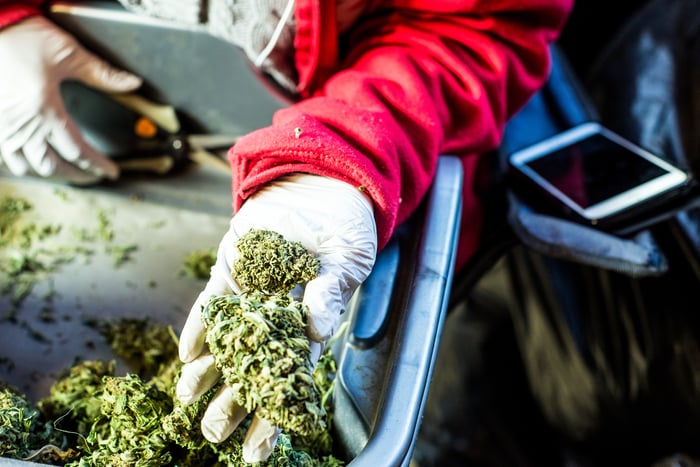The marijuana industry is growing like a weed, and investors can't seem to get enough of pot stocks. Over the trailing-two-year period, the vast majority of marijuana stocks have risen by a triple- or quadruple-digit percentage.
But, truth be told, not a lot is definitively known about the weed industry, which still operates behind a cloud of uncertainty. After all, marijuana is still illegal in every country around the world, save for Uruguay. Within the U.S., despite 29 states having legalized cannabis in some capacity, the federal government maintains a Schedule I classification on the drug, meaning it's entirely illegal, prone to abuse, and has no recognized benefits.

Image source: Getty Images.
In an effort to provide industry insights to Wall Street, investors, and the general public, Marijuana Business Daily publishes its "Marijuana Business Factbook" each year. "Factbook," as the report is better known, provides a plethora of estimates on U.S. cannabis job and sales growth over the coming five-year period. This past week, the latest edition of Factbook was released, which spanned growth estimates between 2017 and 2022. Here are the seven most awe-inspiring statistics provided in that exclusive report.
1. U.S. legal weed sales could rise by nearly 50% in 2018
As is often the case with this annual report, the headline statistic is the expectation of legal weed sales growth in 2018. After generating between $5.8 billion and $6.6 billion in legal sales in 2017 -- Marijuana Business Factbook often lists sales and growth estimates in ranges as opposed to a single projection -- legal pot sales are expected to reach between $7.9 billion and $9.7 billion in 2018. At the midpoint of both estimates, we're looking at 42% year-on-year growth.
The bulk of this increase will come from recreational cannabis sales, and more specifically, from California opening its doors to legal adult-use consumers. Factbook assumes minimum recreational cannabis sales of $500 million in California this year. Additionally, the launch of recreational sales in Massachusetts by this summer, along with Nevada's burgeoning adult-use market -- recreational sales in Nevada kicked off in July 2017 -- should help lift sales.

Image source: Getty Images.
2. Legal sales could hit more than $22 billion by 2022
Over the longer run, legal marijuana sales in the U.S. are estimated to grow by more than 27% per year through 2022 (assuming peak sales estimates each year). After hitting a peak of $6.6 billion in legal sales in 2017, Factbook estimates that between $18 billion and $22.1 billion worth of cannabis could be sold to consumers through legal channels in 2022.
The push to potentially more than $22 billion in sales would be the result of new states legalizing pot in some capacity, as well as organic growth within already legal states. For instance, legal weed sales in Colorado have more than doubled from $699 million in 2014, the first year of recreational marijuana sales in the state, to $1.49 billion as of 2017, according to the Colorado Department of Revenue.
3. Recreational pot sales could double medical sales by 2022
Also of note is the breakdown of expected legal cannabis sales by 2022. According to Factbook, medical marijuana sales are expected to account for between $5.9 billion and $7.3 billion in sales in 2022. Meanwhile, recreational weed should tally between $12.1 billion and $14.8 billion in sales that year. Even though medical sales will have doubled since 2017, recreational marijuana sales will have quadrupled over the same time period. This suggests that recreational customers are a priority for growth-oriented cannabis companies.

Image source: Getty Images.
4. Total U.S. cannabis demand is $52.5 billion
Just how big is the U.S. cannabis market? According to Factbook, legal channel and black market demand combined work out to $52.5 billion. That's a massive number, which has played a big role in pushing marijuana stock valuations ever higher.
Then again, this figure also shows just how far the legal weed industry has to go to stomp out the underground cannabis market. Assuming a midpoint of $6.2 billion in sales last year, this suggests that more than $46 billion in sales were conducted outside the scope of legal channels. Some folks would view this as an opportunity for legal businesses, while others would say that the black market is simply too powerful to overcome. Personally, I believe both views could be right.
5. Marijuana jobs growth to average 21% a year through 2022
Expansion of the cannabis industry in the U.S. isn't just about sales -- it's also about the jobs that are directly and indirectly tied to marijuana. As of today, an estimated 125,000 to 160,000 people are employed within the cannabis industry. By 2022, Factbook predicts that figure could soar to roughly 340,000 jobs. Assuming the current peak estimate of 160,000, this works out to jobs growth of 21% per year through 2022. By comparison, the healthcare industry is only expected to see jobs growth of approximately 2% per year through 2022.

Image source: Getty Images.
6. A greater than $75 billion annual economic impact by 2022
According to Factbook, the cannabis industry could generate an economic impact of between $28 billion and $34 billion in 2018 and surpass an economic impact of $75 billion by 2022. The report notes that: "Estimates for the industry's economic impact are based on retail marijuana sales and incorporates a multiplier of 3.5. For every $1 consumers or patients spend at dispensaries or [recreational] stores, another $2.50 in economic benefit is created in cities, states, and nationwide." Once again, this is about more than just sales. The expansion of the legal cannabis industry could generate jobs and help prop up local economies.
7. Fully legalized cannabis could eventually top U.S. cigarette sales
Lastly, and perhaps most aggressively, Factbook offers up the idea that if marijuana were made legal in the U.S., we could see legal cannabis sales surpass cigarette sales. For context, The Wall Street Journal reported in April 2017 that cigarette industry sales in the U.S. hit an estimated $93.4 billion in 2016. This assumption likely assumes strong pricing power for cannabis products, as well as ongoing weakness in cigarette volumes as consumers quit tobacco products altogether or move away from tobacco in favor of cannabis.
However, the important thing to remember above else, at least for the time being, is that cannabis remains illegal in the United States. As long as ardent cannabis opponent Jeff Sessions heads the Justice Department, there appears to be little chance of altering the drug's scheduling. That's bad news for investors looking to take advantage of the green rush in the U.S., as well as a growth inhibitor for the industry itself.


